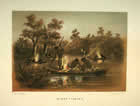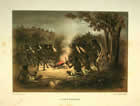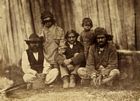The social upheaval and rapid development following the discovery of gold in 1851 perhaps had its greatest impact on the Indigenous population of Central Victoria. The traditional owners of the land on which the first goldrushes took place in Victoria were the Wathaurong (in the Ballarat area) and the Djadjawurrung (in the Mount Alexander area).
Multimedia Content

Inquest - 'Lanky', courtesy of Public Record Office Victoria, Victorian Archives Centre.
Details
Recollection of a Gold Commissioner, courtesy of Private (Robyn Annear).
Details
Night Fishing, by Gill, Samuel Thomas (1818 - 1880), courtesy of Ballarat Fine Art Gallery.
Details
Corroboree, by Gill, Samuel Thomas (1818 - 1880), courtesy of Ballarat Fine Art Gallery.
Details
Warrenheip Hills near Ballarat, 1854, by Von Guerard, Eugene (1812 - 1901), Eugene Von Guerard, courtesy of National Gallery of Victoria.
Details
The Barter, 1854, by Von Guerard, Eugene (1812 - 1901), Eugene Von Guerard
Details
Aboriginal Farmers at Parker's Protectorate, Mt Franklin, c. 1858, by Fauchery, Antoine (1823 - 1861), Daintree, Richard (1832 - 1878), courtesy of State Library of Victoria.
Details
Indigenous Peoples: Overview
Details
Early contacts
The Indigenous peoples living in central Victoria had already been through more than a decade of rapid change, with the pastoral expansion following the expedition of ‘explorer’ Major Thomas Mitchell in 1836. The district saw frontier violence between settlers and Aboriginal people. From the early 1840s, the Aboriginal Protectorate attempted to control where and how the Indigenous population lived – many Djadjawurrung people went to live at the Loddon Protectorate at Franklinford. But the discovery of gold brought change on an unimaginable scale.
The impact of gold
The goldrushes caused environmental damage on a massive scale and also brought terrible hardships to the Indigenous population in the form of alcohol, prostitution, begging and disease. But the goldrushes didn’t just ‘happen’ to Aboriginal people in central Victoria – they were active participants in daily life on the diggings, and for many Indigenous people, the discovery of gold brought new opportunities for economic gain and for cultural exchange.
Popular belief would have it that the Aboriginal population of the 1850s had no capacity to grasp the value of gold. The British press marvelled at how Aboriginal people could have existed for so long in a state of blissful ignorance: ‘generation after generation of aborigines has passed away, unconscious of the riches concealed beneath the surface of their native hunting-grounds, perchance to have made them the most powerful race under the sun’. Gold was indeed a useless commodity in the lives and economies of the traditional owners of the land – until the arrival of the Europeans.
Aboriginal participation
Aboriginal people played a key role in the story of gold in Victoria from the earliest days. Members of the Native Police were assigned in early 1849 to guard the ‘unofficial’ gold discoveries at Daisy Hill, an outstation located 10 miles west of Deep Creek (a branch of the Loddon River).
The history of Aboriginal involvement in events on the goldfields has long been neglected or over-simplified. This website explores Aboriginal participation in daily life on the goldfields and the lasting effects, positive and negative, of the discovery of gold on the Indigenous population.
- References
- Illustrated London News, 24 April 1852, p. 314. Details

